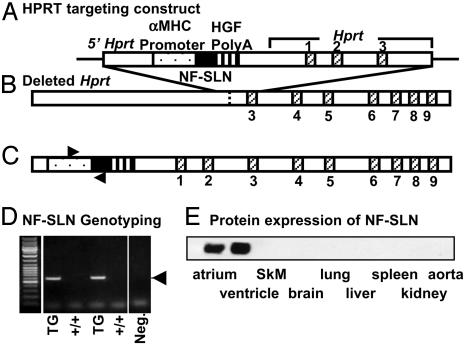Fig. 1.
Strategy for generation of TG mice with cardiac–specific overexpression of NF-SLN. (A) HPRT targeting construct. The targeting vector contains the promoter and the first two exons of Hprt, the α-myosin heavy-chain promoter, NF-SLN, and the human growth factor (HGF) polyadenylation signal sequence. (B) Depleted Hprt. The mutant Hprt gene in the HPRT-deficient E14Tg2a embryonic stem cell line, BK4, is shown with the sites of targeting vector insertion. (C) Transfection of this vector into E14Tg2a cells, together with successful homologous recombination, corrects the HPRT deficiency, restoring the ability of the cells to grow in hypoxanthine/aminopterin/thymidine medium, allowing for rapid screening of positive clones. (D) PCR genotyping was performed by using a 5′ primer within the α-MHC promoter sequence and a 3′ primer within the NF-SLN sequence (forward and reverse arrows in C). Neg., negative control. (E) Protein expression of NF-SLN. The expression levels of NF-SLN were determined in various tissues by Western blot analysis with the anti-FLAG antibody, M2.

